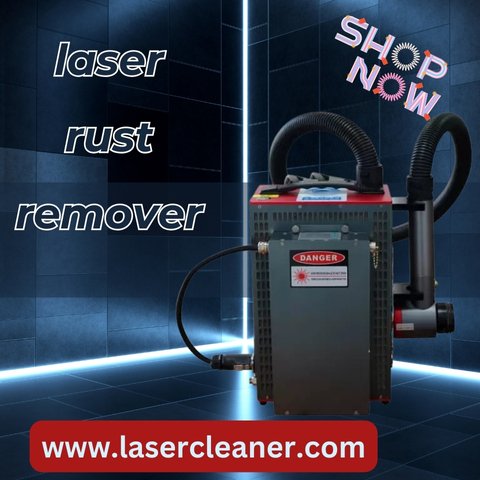Rust is the inevitable nemesis of metal. From vintage tools and classic cars to antique metal artwork and industrial machines, rust silently corrodes everything it touches. Traditionally, rust removal has meant elbow grease, harsh chemicals, abrasive sanding, or even full-scale restoration. But what if a modern tool could eliminate rust with such precision that it leaves the underlying material untouched—regardless of how old or stubborn the rust is?
Enter the laser rust remover, a game-changing technology that’s rapidly becoming a favorite in industries and workshops across the globe. The idea of using concentrated beams of light to remove corrosion seems almost like science fiction, yet it’s very much a reality today. The real question, however, is: Can it handle deeply embedded, decades-old rust without harming the base metal underneath?
Let’s delve into the answer and uncover what makes a laser rust remover not just a cleaning tool, but a transformative solution for metal restoration.
The Science Behind the Beam
To understand how a laser rust remover operates, it’s helpful to grasp the basic principle behind laser cleaning. A laser rust remover emits a highly focused beam of light directed at the rusted surface. This beam heats the rust layer rapidly, causing it to expand and flake off or evaporate from the metal’s surface. The laser energy is absorbed by the rust, which is typically darker and more oxidized than the clean metal beneath. Because clean metal reflects the laser beam rather than absorbing it, there’s minimal risk of damaging the substrate.
This absorption/reflection difference is what makes the laser cleaning process so unique. It’s not just about brute force—it’s about finesse, control, and precision. This is how a laser rust remover can eliminate corrosion while preserving original details, etchings, or fine patterns on even the most delicate objects.
Tackling Decades of Rust
When we talk about decades-old rust, we’re referring to corrosion that has often penetrated deep into the surface, sometimes altering the texture and structure of the metal. For example, an old wrench found in a shed after 40 years might be encased in a thick, crusty layer of reddish-brown rust. Removing this with sandpaper could grind away valuable material. Chemicals might clean the surface but leave behind residues or cause pitting.
This is where the laser rust remover shines—literally and figuratively. With adjustable settings, operators can control the intensity and duration of the laser beam to match the severity of the corrosion. This means that a light sweep can clear surface rust, while a more intense pass can tackle thick, aged oxidation. The technology is precise enough to avoid over-cleaning or etching, making it ideal for heritage conservation and delicate restorations.
Where Precision Matters Most
One of the more exciting applications of laser rust removers is in the restoration of antique and historical items. Museums and collectors often deal with relics that have not only monetary value but immense historical significance. Damaging them even slightly during cleaning is not an option.
Imagine an old bronze sculpture with rusted iron fittings. A chemical or abrasive approach might clean the fittings but also stain or damage the surrounding bronze. A laser rust remover, by contrast, can be fine-tuned to remove corrosion selectively, one layer at a time, preserving the aesthetic and structural integrity of the item.
In the automotive restoration world, enthusiasts have started using laser rust removers to clean frames, engine components, and body panels. The process strips away rust without warping the metal, which is especially important on older vehicles where metal thickness varies and replacement parts are scarce.
Industrial Adoption and Modern Use Cases
Industries like shipbuilding, aerospace, construction, and manufacturing are increasingly incorporating laser rust removers into their workflows. Large steel structures, pipelines, and heavy machinery often sit exposed to the elements, accumulating rust that must be removed before repainting or re-coating.
Traditional methods involve sandblasting, which is messy, abrasive, and often toxic due to the dust and waste materials generated. Laser rust removers provide a clean, quiet, and environmentally friendly alternative. There’s no need for blasting media, no chemical runoff, and far less clean-up. This efficiency is not only better for workers but also for the bottom line of the operation.
Portability and Ease of Use
Modern laser rust remover units come in portable formats, often resembling a backpack or handheld device connected to a small laser gun. This portability makes it possible to perform rust removal in tight or awkward spaces—on the underside of a car, around engine mounts, or on complex machinery parts.
The controls are usually intuitive, with operators able to adjust power levels, frequency, and beam focus. Training for basic operation doesn’t take long, and for many small businesses, the ease of use is a compelling reason to invest.
Environmental and Safety Considerations
Unlike chemical rust removers that release fumes, or sandblasting that creates airborne particles, laser rust removal produces minimal waste. The main byproducts are tiny solid particles and a little smoke, which can be easily managed with local exhaust ventilation.
From a safety perspective, the lasers used in laser rust removers are powerful and require protective eyewear and proper shielding. However, when operated according to guidelines, they are significantly safer than handling caustic acids or blasting materials at high speeds.
Governments and safety regulators are beginning to recognize laser cleaning as a preferred method for environmentally responsible corrosion control. It meets strict environmental codes in many jurisdictions and supports initiatives aimed at reducing industrial pollution.
A Promising Future for Restoration and Beyond
The versatility of laser rust removers suggests that their adoption is only just beginning. As the technology becomes more affordable and compact, more workshops, garages, and restoration professionals are incorporating them into their toolkits.
What’s especially noteworthy is the way this technology blends power and precision. You no longer need to choose between speed and delicacy. Whether you’re a DIY enthusiast restoring a vintage sign or an industrial engineer preparing massive steel beams for repainting, a laser rust remover provides the control you need to get the job done right.
It also opens up new possibilities for creative industries—artists, metal sculptors, and furniture designers are exploring how lasers can be used not just to clean but to finish and texture surfaces in novel ways. The ability to remove rust without leaving behind any contaminants is especially useful when preparing metal for welding or bonding, as it ensures stronger, more reliable joins.
Final Thoughts
So, can a laser rust remover clean away decades-old rust without damaging the original metal? The answer is a confident yes—when used correctly, it can not only eliminate corrosion but do so with a level of control and precision unmatched by any other rust removal method. This makes it an indispensable tool for industries, artisans, restorers, and everyday users alike.
As more people discover what’s possible with this powerful device, the laser rust remover is poised to become a staple in the fight against corrosion. Whether you’re reviving history, maintaining equipment, or simply giving a second life to a metal object that deserves better, it’s clear that this tool is more than a cleaner—it’s a revolution in restoration.


